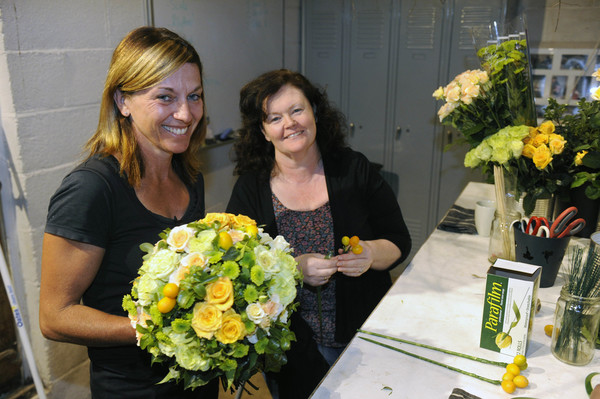By KATHRYN BERMINGHAM
PRECEDE: ELEVEN years ago, Georgie and Gordon Campbell made a tree change to Tynong – and it’s paid dividends. With 30 years’ experience behind her, Georgie runs floristry classes out of a renovated dairy barn on the property. KATHRYN BERMINGHAM recently got the chance to try her hand at floral design.
PULL QUOTE:
“If you’d asked me before we moved, I wouldn’t have been able to tell you anything about Tynong. But it’s been a great thing for us – we really love it here.
IT’S almost 6.30pm on a Wednesday, and the sun is setting over Tynong when I pull into Georgie Campbell’s driveway.
Like many others in the area, Georgie and Gordon Campbell’s home is situated on several acres, with ducks, chickens and dogs roaming. Yet unlike many of the surrounding properties, it’s not working the land that generates income for the couple.
It was 11 years ago that they decided to make the move from suburban Bayswater out to Tynong. Georgie owned and ran the successful floristry business ‘Bloomsbury Flowers’ in Camberwell and Gordon ran a commercial construction company. Life was hectic.
“We decided we didn’t’ want to live like that anymore,” Georgie explained.
“There was nothing keeping us there so we thought, why not?
“My parents were horrified.”
The home they are now living in was then a run down farmhouse. With Georgie’s decorative eye and Gordon’s construction skills, the old dairy was soon transformed into their home.
It wasn’t until a couple of years after the move that Georgie began to tire of the commute to Camberwell and decided to sell the business. It was Gordon who suggested renovating the dairy building so that she could begin teaching. Initially, Georgie was sceptical.
“I thought ‘who on Earth would come all the way out here to take a class?’”
As it happened, there was enough interest in floristry to fill three classes. Georgie’s since gone from strength to strength, designing a six-week course as well as hosting regular one-day workshops. To add to her busy schedule, she also specialises in floristry for weddings and special events.
It’s a Wednesday evening, and Georgie’s already run a four-hour floristry class that morning but is bursting with energy ahead of tonight’s session.
Beautifully outfitted and decorated, the old dairy the perfect setting for visitors to learn the ins and outs of the craft.
One half of the room is taken up by a big, rectangular table surrounded by stools, ready for the class. The other half offers several comfortable chairs and a kitchenette equipped with tea, coffee and sweets, which guests help themselves to.
Although the class officially begins at seven, Georgie’s students arrive a little before and enjoy the relaxed atmosphere before the start.
Tonight’s lesson will involve making two floral posies and decorating vases. Though half the class is new to floristry and half are back for their “second term,” Georgie has planned a class that everyone can take part in.
We start out decorating our vases, which involves securing pieces of bark onto tin cans with string. The bark is local, as are all the flowers. Georgie offers her students a good mix of instruction and creative control, and everyone’s creations have their own touch of individuality. Vase-decorating is trickier than I expected, but there are plenty of helping hands around to show me the way.
Once the vases were done, it’s time to create the posies. Tonight’s posy would have a variety of different cream, orange and white flowers, as well as green foliage and accentuated with some kumquats, which Georgie says will give the posy a “fresh and citrusy” look.
Tonight is the first class of the term, and students will learn the integral floristry technique of spiralling.
Georgie gives each student several bunches of flowers and foliage, and the rest was left to her pupils as she demonstrated the technique.
The first thing that needed to be done was the removal of the thorns and leaves from the stems of the flowers. By running a cloth from the top to the bottom of the stem, students were left with a much smoother flower, both easier to work with and better to look at.
As Georgie explained the basics of spiralling, I began to realise what an art floristry was, and that I had seriously undervalued the craft. Each flower or set of flowers must be carefully intertwined, and much thought is devoted to the placement of certain flowers within the posy.
For the first attempt, Georgie instructs the class step-by-step, detailing which flowers or foliage should be used at various times. Students then evaluate their creations and disassemble them, and are left to use their own judgment in assembling the posy the second time around. Once the bouquets are finished, Georgie teaches the class how to tie them and they put them into the vases – ready for display. Though there were individual points of difference, each student produced a pretty posy and I left equally proud and surprised by what I had created. And the best part is you can take it all home! It’s a world away from the bustle of the streets of Camberwell, and although it hasn’t always been easy, Georgie says, there’s never been a time when the move hasn’t been worth it.
“If you’d asked me before we moved, I wouldn’t have even been able to tell you anything about Tynong,” she said.
“But it’s been a great thing for us – we really love it here.”















